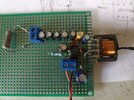throbscottle
Well-Known Member
Suppose I connect a buck converter with a transformer as the inductor so I can get an extra supply.
Is this better than using 2 converters? The main supply would be 5v at maybe 100mA, the tertiary winding would supply -24v at 10-20mA. It would be nice to pull a low AC supply off it as well but that might be asking a bit much.
Is this a good way to go?
Is this better than using 2 converters? The main supply would be 5v at maybe 100mA, the tertiary winding would supply -24v at 10-20mA. It would be nice to pull a low AC supply off it as well but that might be asking a bit much.
Is this a good way to go?

